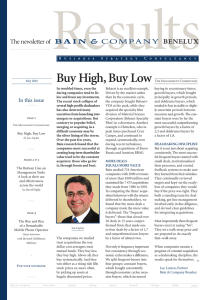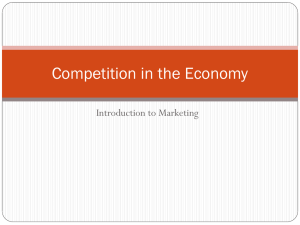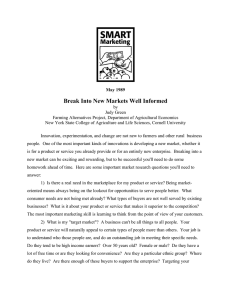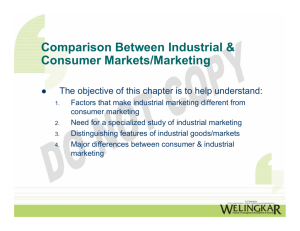Document 12878455
advertisement
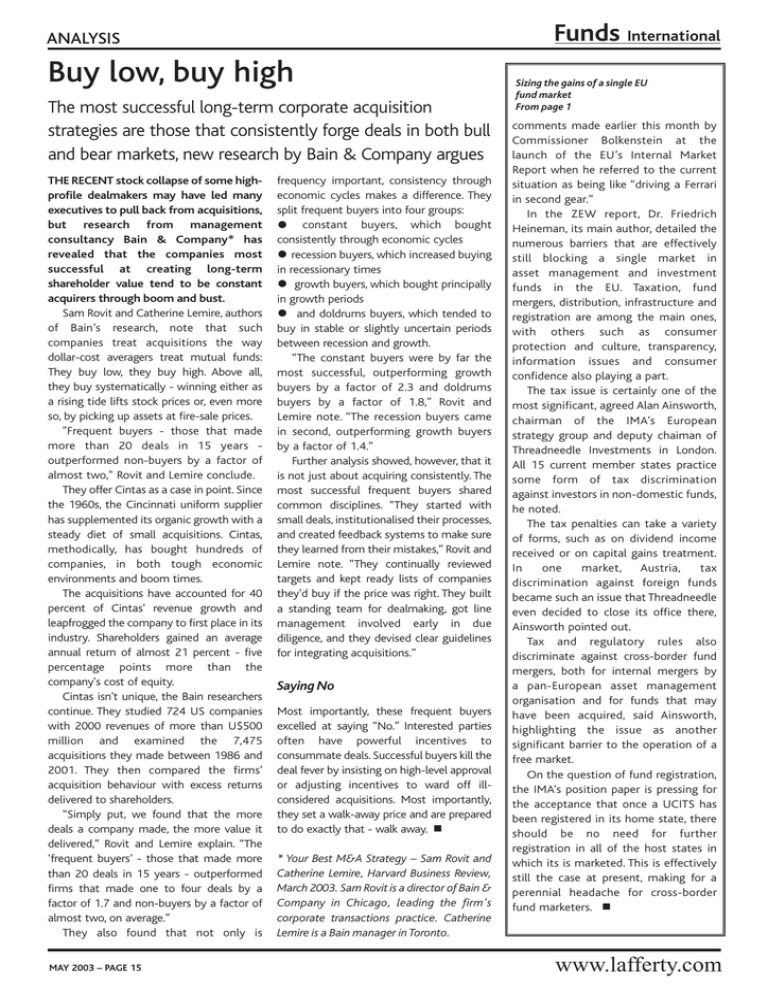
Funds International ANALYSIS Buy low, buy high The most successful long-term corporate acquisition strategies are those that consistently forge deals in both bull and bear markets, new research by Bain & Company argues THE RECENT stock collapse of some highprofile dealmakers may have led many executives to pull back from acquisitions, but research from management consultancy Bain & Company* has revealed that the companies most successful at creating long-term shareholder value tend to be constant acquirers through boom and bust. Sam Rovit and Catherine Lemire, authors of Bain’s research, note that such companies treat acquisitions the way dollar-cost averagers treat mutual funds: They buy low, they buy high. Above all, they buy systematically - winning either as a rising tide lifts stock prices or, even more so, by picking up assets at fire-sale prices. "Frequent buyers - those that made more than 20 deals in 15 years outperformed non-buyers by a factor of almost two," Rovit and Lemire conclude. They offer Cintas as a case in point. Since the 1960s, the Cincinnati uniform supplier has supplemented its organic growth with a steady diet of small acquisitions. Cintas, methodically, has bought hundreds of companies, in both tough economic environments and boom times. The acquisitions have accounted for 40 percent of Cintas' revenue growth and leapfrogged the company to first place in its industry. Shareholders gained an average annual return of almost 21 percent - five percentage points more than the company's cost of equity. Cintas isn't unique, the Bain researchers continue. They studied 724 US companies with 2000 revenues of more than U$500 million and examined the 7,475 acquisitions they made between 1986 and 2001. They then compared the firms' acquisition behaviour with excess returns delivered to shareholders. “Simply put, we found that the more deals a company made, the more value it delivered,” Rovit and Lemire explain. “The ‘frequent buyers’ - those that made more than 20 deals in 15 years - outperformed firms that made one to four deals by a factor of 1.7 and non-buyers by a factor of almost two, on average.” They also found that not only is MAY 2003 – PAGE 15 frequency important, consistency through economic cycles makes a difference. They split frequent buyers into four groups: constant buyers, which bought consistently through economic cycles recession buyers, which increased buying in recessionary times growth buyers, which bought principally in growth periods and doldrums buyers, which tended to buy in stable or slightly uncertain periods between recession and growth. “The constant buyers were by far the most successful, outperforming growth buyers by a factor of 2.3 and doldrums buyers by a factor of 1.8,” Rovit and Lemire note. “The recession buyers came in second, outperforming growth buyers by a factor of 1.4.” Further analysis showed, however, that it is not just about acquiring consistently. The most successful frequent buyers shared common disciplines. “They started with small deals, institutionalised their processes, and created feedback systems to make sure they learned from their mistakes,” Rovit and Lemire note. “They continually reviewed targets and kept ready lists of companies they'd buy if the price was right. They built a standing team for dealmaking, got line management involved early in due diligence, and they devised clear guidelines for integrating acquisitions.” • • • • Saying No Most importantly, these frequent buyers excelled at saying “No.” Interested parties often have powerful incentives to consummate deals. Successful buyers kill the deal fever by insisting on high-level approval or adjusting incentives to ward off illconsidered acquisitions. Most importantly, they set a walk-away price and are prepared to do exactly that - walk away. ■ * Your Best M&A Strategy – Sam Rovit and Catherine Lemire, Harvard Business Review, March 2003. Sam Rovit is a director of Bain & Company in Chicago, leading the firm's corporate transactions practice. Catherine Lemire is a Bain manager in Toronto. Sizing the gains of a single EU fund market From page 1 comments made earlier this month by Commissioner Bolkenstein at the launch of the EU’s Internal Market Report when he referred to the current situation as being like “driving a Ferrari in second gear.” In the ZEW report, Dr. Friedrich Heineman, its main author, detailed the numerous barriers that are effectively still blocking a single market in asset management and investment funds in the EU. Taxation, fund mergers, distribution, infrastructure and registration are among the main ones, with others such as consumer protection and culture, transparency, information issues and consumer confidence also playing a part. The tax issue is certainly one of the most significant, agreed Alan Ainsworth, chairman of the IMA’s European strategy group and deputy chaiman of Threadneedle Investments in London. All 15 current member states practice some form of tax discrimination against investors in non-domestic funds, he noted. The tax penalties can take a variety of forms, such as on dividend income received or on capital gains treatment. In one market, Austria, tax discrimination against foreign funds became such an issue that Threadneedle even decided to close its office there, Ainsworth pointed out. Tax and regulatory rules also discriminate against cross-border fund mergers, both for internal mergers by a pan-European asset management organisation and for funds that may have been acquired, said Ainsworth, highlighting the issue as another significant barrier to the operation of a free market. On the question of fund registration, the IMA’s position paper is pressing for the acceptance that once a UCITS has been registered in its home state, there should be no need for further registration in all of the host states in which its is marketed. This is effectively still the case at present, making for a perennial headache for cross-border fund marketers. ■ www.lafferty.com
